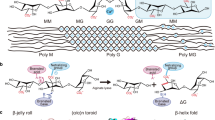Summary
Alginase-secreting bacteria associated with actively growing tissues of the marine Phaeophyta speciesSargassum fluitans andS. natans have been isolated and evaluated for their ability to degrade alginate (ALG), carboxymethylcellulose, and agar. Of seven isolates selected for their ability to grow on 2% agar containing 1% sodium alginate, none were able to grow on either 2% agar or 2% agar supplemented with 0.1% carboxymethylcellulose. Two of these with fermentative potential, i.e., ALG-A and ALG-G, showed selective activities with respect to their ability to degrade native alginate and/or take up the products resulting from alginate degradation. The ALG-A isolate was able to rapidly degrade native alginate with the generation of a stable polymer fraction and small oligouronides, most of which were dissimilated for growth. The ALG-G isolate was able to completely degrade native alginate with the accumulation of significant quantities of unsaturated dimeric and trimeric oligouronides. A limit polymer was generated from the action of a polymannuronan-specific extracellular alginate lyase purified from exponential cultures of the ALG-A organism. This product proved to be an effective substrate for the alginate lyase activity obtained from the medium of exponential phase cultures of the ALG-G isolate, and upon incubation with concentrated and dialyzed ALG-G medium was converted to the products that were observed to accumulate in the medium of the ALG-G isolate grown on native alginate. These organisms represent examples of the microflora associated with actively growingSargassum tissues, each with a selective ability to degrade and dissimilate the biomass of the marine brown algae.
Similar content being viewed by others
References
Blumenkrantz, N. and G. Asboe-Hansen. 1973. New method for quantitative determination of uronic acids. Anal. Bichem. 54: 484–489.
Boyd, J. and J.R. Turvey. 1977. Isolation of a poly-α-l-guluronate lyase fromKlebsiella aerogenes. Carbohydrate Res. 57: 163–171.
Davidson, I.W., I.W. Sutherland and C.J. Lawson. 1976. Purification of an alginate lyase from a marine bacterium. Biochem. J. 159: 707–713.
Davidson, I.W., C.J. Lawson and I.W. Sutherland. 1977. An alginate lyase fromAzotobacter vinelandii phage. J. Gen. Microbiol. 98: 223–229.
Doubet, R.S. and R.S. Quatrano. 1984. Properties of alginate lyases from marine bacteria. Appl. Environ. Microbiol. 47: 699–703.
Dubois, M., K.A. Gilles, J.K. Hamilton, P.A. Rebers and F. Smith. 1956. Colorimetric method for the determination of sugars and related substances. Anal. Chem. 28: 350–356.
Favorov, V.V., E.I. Vozhova, V.A. Denisenko and L.A. Elyakova. 1979. A study of the reaction catalyzed by alginate lyase VI from the sea mollusc,Littorina sp. Biochim. Biophys. Acta 569: 259–266.
Hansen, J.B., R.S. Doubet and J. Ram. 1984. Alginase enzyme production byBacillus circulans. Appl. Environ. Microbiol. 47: 704–709.
Kashiwabara, Y., H. Suzuki and K. Nisizawa. 1969. Alginate lyases of Pseudomonads. J. Biochem. 66: 503–512.
Muramatsu, T. 1984. Additional evidence for substrate specificities of alginate lyase isozymes fromTurbo cornutus and chemical modification of cys, trp, and lys residues. Agric. Biol. Chem. 48: 811–813.
Nakada, H.I. and P.C. Sweeny. 1967. Alginic acid degradation by eliminases from abalone hepatopancreas. J. Biol. Chem. 242: 845–851.
Preiss, J. and G. Ashwell. 1962. Alginic acid metabolism in bacteria. I. Enzymatic formation of unsaturated oligosaccharides and 4-deoxy-l-erythro-5-hexoseulose uronic acid. J. Biol. Chem. 237: 309–316.
Preston, J.F., T. Romeo, J.C. Bromley, R.W. Robinson and H.C. Aldrich. 1985. Alginate lyase-secreting bacteria associated with the algal genusSargassum. In: Developments in Industrial Microbiology (Underkofler, L.A., ed.), Vol. 26. pp. 727–740, Society for Industrial Microbiology.
Quatrano, R.S. and B.A. Caldwell. 1978. Isolation of a unique marine bacterium capable of growth on a wide variety of polysaccharides from macroalgae. Appl. Environ. Microbiol. 36: 979–981.
Romeo, T., J.C. Bromley and J.F. Preston. 1986. Alginate lyases of varying substrate specificities from marine bacteria. In: Biomass Energy Development (Smith, W.H., ed.), pp. 303–320, Plenum Publishing Corporation.
Romeo, T. and J.F. Preston, 1986. L.C. analysis of the depolymerization of (1→4)-B-d-mannuronan by an extracellular alginate lyase from a marine bacterium. Carbohydrate Res., in the press.
Sutherland, I.W. and G.A. Keen. 1981. Alginases fromBenekia pelagia andPseudomonas spp. J. Appl. Biochem. 3: 48–57.
Weissbach, A. and J. Hurwitz. 1959. The formation of 2-keto-3-deoxyheptanoic acid in extracts ofEscherichia coli B. J. Biol. Chem. 234: 705–709.
Author information
Authors and Affiliations
Rights and permissions
About this article
Cite this article
Preston, J.F., Romeo, T. & Bromley, J.C. Selective alginate degradation by marine bacteria associated with the algal genusSargassum . Journal of Industrial Microbiology 1, 235–244 (1986). https://doi.org/10.1007/BF01569277
Received:
Revised:
Accepted:
Issue Date:
DOI: https://doi.org/10.1007/BF01569277




